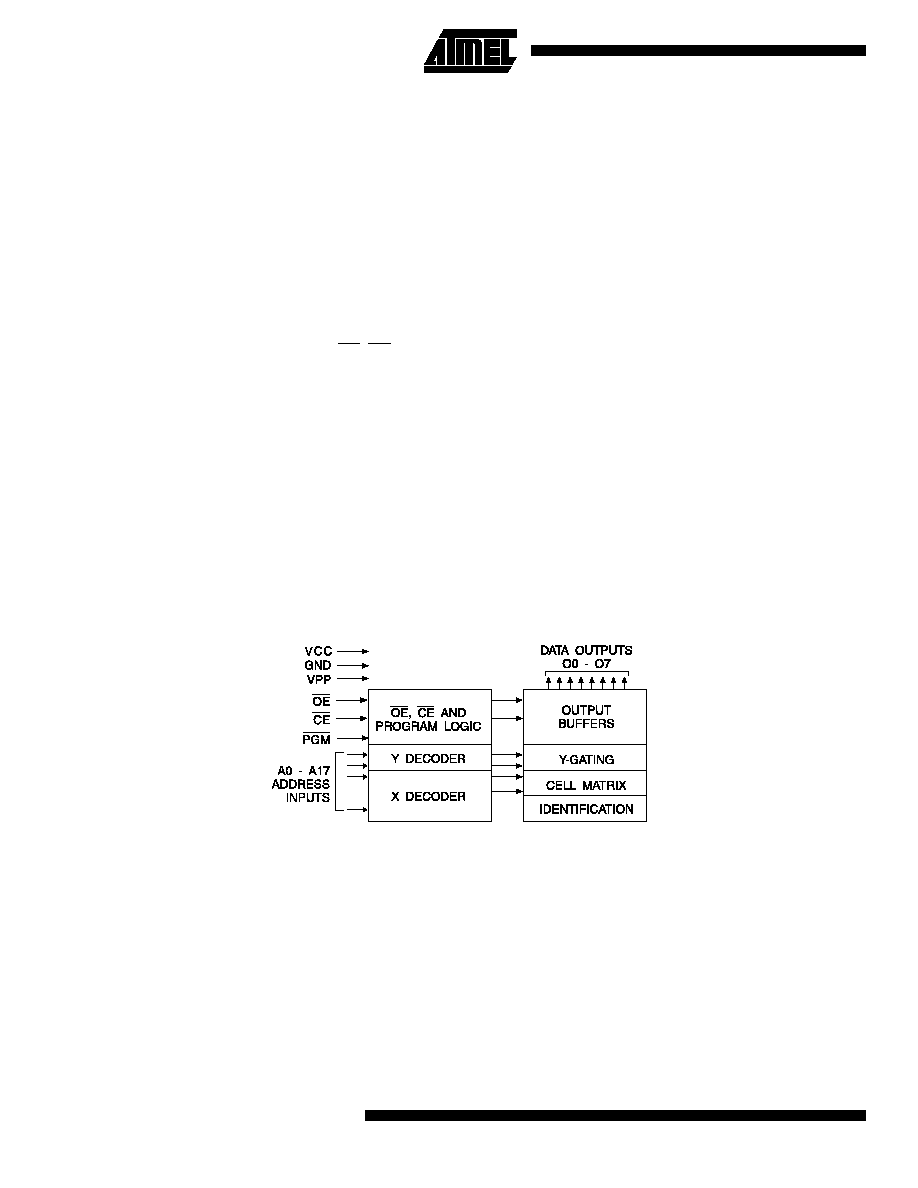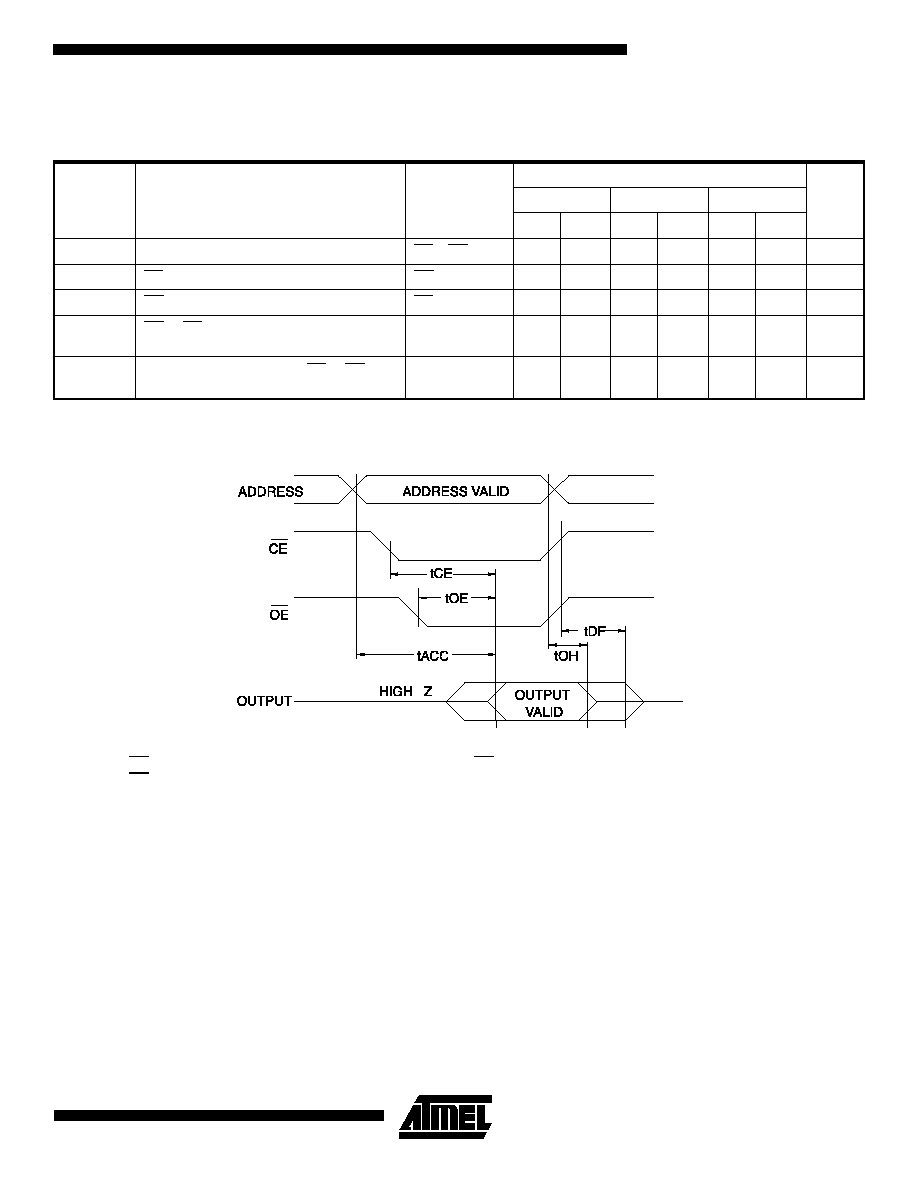
1
PLCC, Top View
5
6
7
8
9
10
11
12
13
29
28
27
26
25
24
23
22
21
A7
A6
A5
A4
A3
A2
A1
A0
O0
A14
A13
A8
A9
A11
OE
A10
CE
O7
4
3
2
1
32
31
30
14
15
16
17
18
19
20
O1
O2
GND
O3
O4
O5
O6
A12
A15
A16
VPP
VCC
PGM
A17
Features
∑
Fast Read Access Time ≠ 90 ns
∑
Dual Voltage Range Operation
≠ Unregulated Battery Power Supply Range, 2.7V to 3.6V
or Standard 5V
± 10% Supply Range
∑
Compatible with JEDEC Standard AT27C020
∑
Low-power CMOS Operation
≠ 20 µA max. (Less than 1 µA Typical) Standby for V
CC
= 3.6V
≠ 29 mW max. Active at 5 MHz for V
CC
= 3.6V
∑
Wide Selection of JEDEC Standard Packages
≠ 32-lead PLCC
≠ 32-lead TSOP (8 x 20 mm)
≠ 32-lead VSOP (8 x 14 mm)
∑
High Reliability CMOS Technology
≠ 2,000V ESD Protection
≠ 200 mA Latch-up Immunity
∑
Rapid
TM
Programming Algorithm ≠ 100 µs/Byte (Typical)
∑
CMOS and TTL Compatible Inputs and Outputs
≠ JEDEC Standard for LVTTL and LVBO
∑
Integrated Product Identification Code
∑
Commercial and Industrial Temperature Ranges
Description
The AT27BV020 is a high-performance, low-power, low-voltage, 2,097,152-bit, one-
time programmable, read-only memory (OTP EPROM) organized as 256K by 8 bits. It
requires only one supply in the range of 2.7 to 3.6V in normal read mode operation,
making it ideal for fast, portable systems using either regulated or unregulated battery
power.
2-megabit
(256K x 8)
Unregulated
Battery-Voltage
TM
High-speed
OTP EPROM
AT27BV020
TSOP, VSOP Top View
Type 1
1
2
3
4
5
6
7
8
9
10
11
12
13
14
15
16
32
31
30
29
28
27
26
25
24
23
22
21
20
19
18
17
A11
A9
A8
A13
A14
A17
PGM
VCC
VPP
A16
A15
A12
A7
A6
A5
A4
OE
A10
CE
O7
O6
O5
O4
O3
GND
O2
O1
O0
A0
A1
A2
A3
Rev. 0902D≠04/01
Pin Configurations
Pin Name
Function
A0 - A17
Addresses
O0 - O7
Outputs
CE
Chip Enable
OE
Output Enable
PGM
Program Strobe
NC
No Connect
(continued)

AT27BV020
2
Atmel's innovative design techniques provide fast speeds
that rival 5V parts while keeping the low power consump-
tion of a 3V supply. At V
C C
= 2.7V, any byte can be
accessed in less than 90 ns. With a typical power dissipa-
tion of only 18 mW at 5 MHz and V
CC
= 3V, the AT27BV020
consumes less than one fifth the power of a standard 5V
EPROM. Standby mode supply current is typically less
than 1 µA at 3V. The AT27BV020 simplifies system design
and stretches battery lifetime even further by eliminating
the need for power supply regulation
The AT27BV020 is available in industry standard JEDEC
approved one-time programmable (OTP) plastic PLCC,
TSOP and VSOP packages, as well as a 42-ball, 1 mm
pitch. All devices feature two-line control (CE, OE) to give
designers the flexibility to prevent bus contention.
The AT27BV020 operating with V
CC
at 3.0V produces TTL
level outputs that are compatible with standard TTL logic
devices operating at V
CC
= 5.0V. At V
CC
= 2.7V, the part is
compatible with JEDEC approved low voltage battery oper-
ation (LVBO) interface specifications. The device is also
capable of standard 5-volt operation making it ideally suited
for dual supply range systems or card products that are
pluggable in both 3-volt and 5-volt hosts.
Atmel's AT27BV020 has additional features to ensure high
quality and efficient production use. The Rapid
TM
Program-
ming Algorithm reduces the time required to program the
part and guarantees reliable programming. Programming
time is typically only 100 µs/byte. The Integrated Product
Identification Code electronically identifies the device and
manufacturer. This feature is used by industry standard
programming equipment to select the proper programming
algorithms and voltages. The AT27BV020 programs
exactly the same way as a standard 5V AT27C020 and
uses the same programming equipment.
System Considerations
Switching between active and standby conditions via the
Chip Enable pin may produce transient voltage excursions.
Unless accommodated by the system design, these tran-
sients may exceed data sheet limits, resulting in device
nonconformance. At a minimum, a 0.1 µF high frequency,
low inherent inductance, ceramic capacitor should be uti-
lized for each device. This capacitor should be connected
between the V
CC
and Ground terminals of the device, as
close to the device as possible. Additionally, to stabilize the
supply voltage level on printed circuit boards with large
EPROM arrays, a 4.7 µF bulk electrolytic capacitor should
be utilized, again connected between the V
CC
and Ground
terminals. This capacitor should be positioned as close as
possible to the point where the power supply is connected
to the array.
Block Diagram

AT27BV020
3
Note:
1. Minimum voltage is -0.6V DC which may undershoot to -2.0V for pulses of less than 20 ns.Maximum output pin voltage is
V
CC
+ 0.75V DC which may be exceeded if certain precautions are observed (consult application notes) and which may
overshoot to +7.0V for pulses of less than 20 ns.
Notes:
1. X Can be V
IL
or V
IH
.
2. Read, output disable, and standby modes require, 2.7V
V
CC
3.6V, or 4.5V V
CC
5.5V.
3. Refer to Programming Characteristics. Programming modes requires V
CC
= 6.5V.
4. V
H
= 12.0 ± 0.5V.
5. Two identifier bytes may be selected. All Ai inputs are held low (V
IL
), except A9 which is set to V
H
and A0 which is toggled
low (V
IL
) to select the Manufacturer's Identification byte and high (V
IH
) to select the Device Code byte.
Absolute Maximum Ratings*
Temperature under Bias .................................. -40∞C to +85∞C
*NOTICE:
Stresses beyond those listed under "Absolute
Maximum Ratings" may cause permanent dam-
age to the device. This is a stress rating only and
functional operation of the device at these or any
other conditions beyond those indicated in the
operational sections of this specification is not
implied. Exposure to absolute maximum rating
conditions for extended periods may affect
device reliability.
Storage Temperature ..................................... -65∞C to +125∞C
Voltage on Any Pin with
Respect to Ground .........................................-2.0V to +7.0V
(1)
Voltage on A9 with
Respect to Ground ......................................-2.0V to +14.0V
(1)
V
PP
Supply Voltage with
Respect to Ground .......................................-2.0V to +14.0V
(1)
Operating Modes
Mode / Pin
CE
OE
PGM
Ai
V
PP
V
CC
Outputs
Read
(2)
V
IL
V
IL
X
(1)
Ai
X
V
CC
(2)
D
OUT
Output Disable
(2)
X V
IH
X
X
X
V
CC
(2)
High-Z
Standby
(2)
V
IH
X
X
X
X
V
CC
(2)
High-Z
Rapid Program
(3)
V
IL
V
IH
V
IL
Ai
V
PP
V
CC
(3)
D
IN
PGM Verify
(3)
V
IL
V
IL
V
IH
Ai
V
PP
V
CC
(3)
D
OUT
PGM Inhibit
(3)
V
IH
X
X
X
V
PP
V
CC
(3)
High-Z
Product Identification
(3)(5)
V
IL
V
IL
X
A9 = V
H
(4)
A0 = V
IH
or V
IL
A1 - A17 = V
IL
X
V
CC
(3)
Identification
Code

AT27BV020
4
Notes:
1.
V
CC
must be applied simultaneously with or before
V
PP
, and removed simultaneously with or after V
PP
.
2.
V
PP
may be connected directly to V
CC
, expect during programming. The supply current would then be the sum of I
CC
and I
PP
.
DC and AC Operating Conditions for Read Operation
AT27BV020-90
AT27BV020-12
AT27BV020-15
Operating Temperature
(Case)
Com.
0∞C - 70∞C
0∞C - 70∞C
0∞C - 70∞C
Ind.
-40∞C - 85∞C
-40∞C - 85∞C
-40∞C - 85∞C
V
CC
Power Supply
2.7V to 3.6V
2.7V to 3.6V
2.7V to 3.6V
5V ± 10%
5V ± 10%
5V ± 10%
DC and Operating Characteristics for Read Operation
Symbol
Parameter
Condition
Min
Max
Units
V
CC
= 2.7V to 3.6V
I
LI
Input Load Current
V
IN
= 0V to V
CC
±1
µA
I
LO
Output Leakage Current
V
OUT
= 0V to V
CC
±5
µA
I
PP1
(2)
V
PP
(1)
Read/Standby Current
V
PP
= V
CC
10
µA
I
SB
V
CC
(1)
Standby Current
I
SB1
(CMOS), CE = V
CC
=
± 0.3V
20
µA
I
SB2
(TTL), CE = 2.0 to V
CC
+ 0.5V
100
µA
I
CC
V
CC
Active Current
f = 5 MHz, I
OUT
= 0 mA, CE = V
IL
, V
CC
= 3.6V
8
mA
V
IL
Input Low Voltage
V
CC
= 3.0 to 3.6V
-0.6
0.8
V
V
CC
= 2.7 to 3.6V
-0.6
0.2 x V
CC
V
V
IH
Input High Voltage
V
CC
= 3.0 to 3.6V
2.0
V
CC
+ 0.5
V
V
CC
= 2.7 to 3.6V
0.7 x V
CC
V
CC
+ 0.5
V
V
OL
Output Low Voltage
I
OL
= 2.0 mA
0.4
V
I
OL
= 100 µA
0.2
V
I
OL
= 20 µA
0.1
V
V
OH
Output High Voltage
I
OH
= -2.0
=mA
2.4
V
I
OH
= -100 µA
V
CC
- 0.2
V
I
OH
= -20 µA
V
CC
- 0.1
V
V
CC
= 4.5V to 5.5V
I
LI
Input Load Current
V
IN
= 0V to V
CC
±1
µA
I
LO
Output Leakage Current
V
OUT
= 0V to V
CC
±5
µA
I
PP1
(2)
V
PP
(1)
Read/Standby Current
V
PP
= V
CC
10
µA
I
SB
V
CC
(1)
Standby Current
I
SB1
(CMOS), CE = V
CC
± 0.3V
100
µA
I
SB2
(TTL), CE = 2.0 to V
CC
+ 0.5V
1
mA
I
CC
V
CC
Active Current
f = 5 MHz, I
OUT
= 0 mA, CE = V
IL
25
mA
V
IL
Input Low Voltage
-0.6
0.8
V
V
IH
Input High Voltage
2.0
V
CC
+ 0.5
V
V
OL
Output Low Voltage
I
OL
= 2.1 mA
0.4
V
V
OH
Output High Voltage
I
OH
= -400 µA
2.4
V

AT27BV020
5
Note:
2,3,4,5. ≠ See "AC Waveforms for Read Operation".
AC Waveforms for Read Operation
(1)
Notes:
1. Timing measurement references are 0.8V and 2.0V. Input AC drive levels are 0.45V and 2.4V, unless otherwise specified.
2. OE may be delayed up to t
CE
- t
OE
after the falling edge of CE without impact on t
CE
.
3. OE may be delayed up to t
ACC
- t
OE
after the address is valid without impact on t
ACC
.
4. This parameter is only sampled and is not 100% tested.
5. Output float is defined as the point when data is no longer driven.
AC Characteristics for Read Operation
V
CC
= 2.7V to 3.6V and 4.5V to 5.5V
Symbol
Parameter
Condition
AT27BV020
Units
-90
-12
-15
Min
Max
Min
Max
Min
Max
t
ACC
(3)
Address to Output Delay
CE = OE = V
IL
90
120
150
ns
t
CE
(2)
CE to Output Delay
OE = V
IL
90
120
150
ns
t
OE
(2)(3)
OE to Output Delay
CE = V
IL
50
50
60
ns
t
DF
(4)(5)
OE or CE High to Output Float,
whichever occurred first
40
40
50
ns
t
OH
Output Hold from Address, CE or OE,
whichever occurred first
0
0
0
ns




